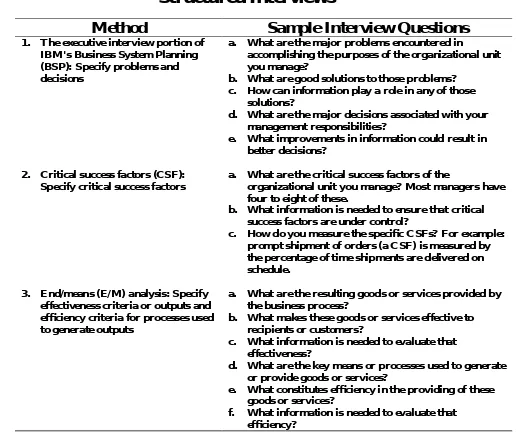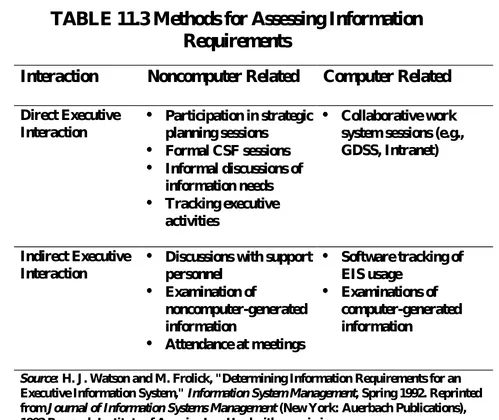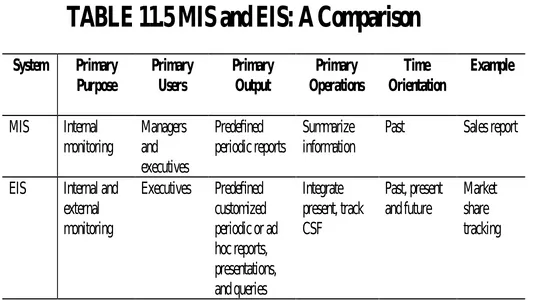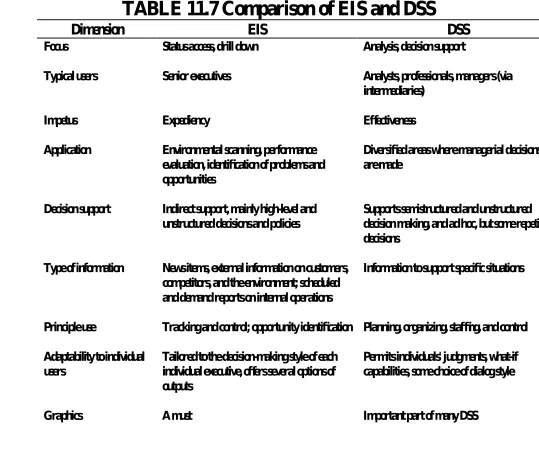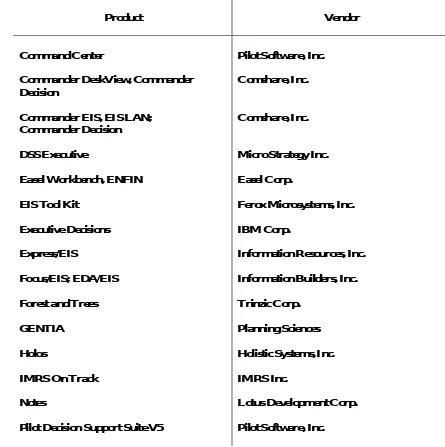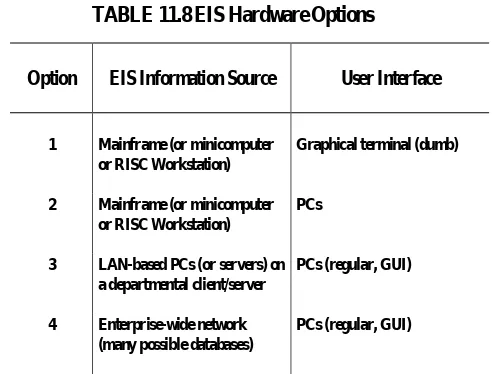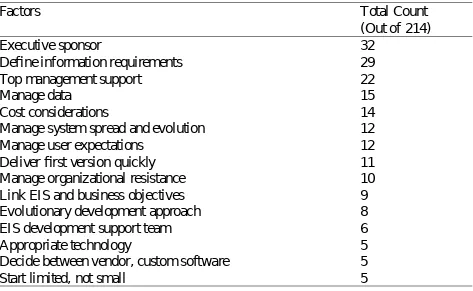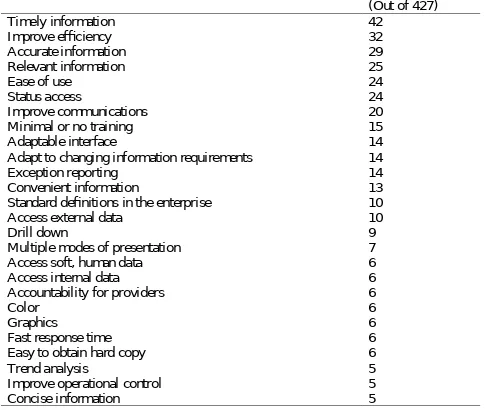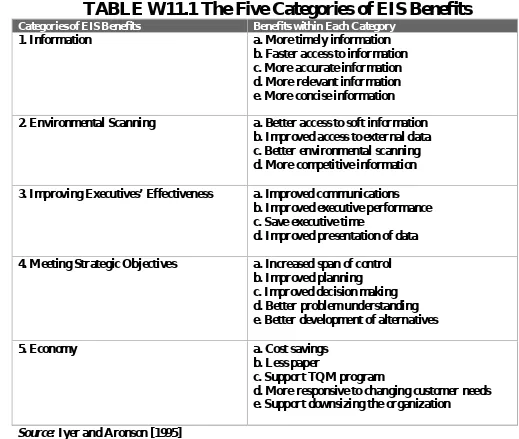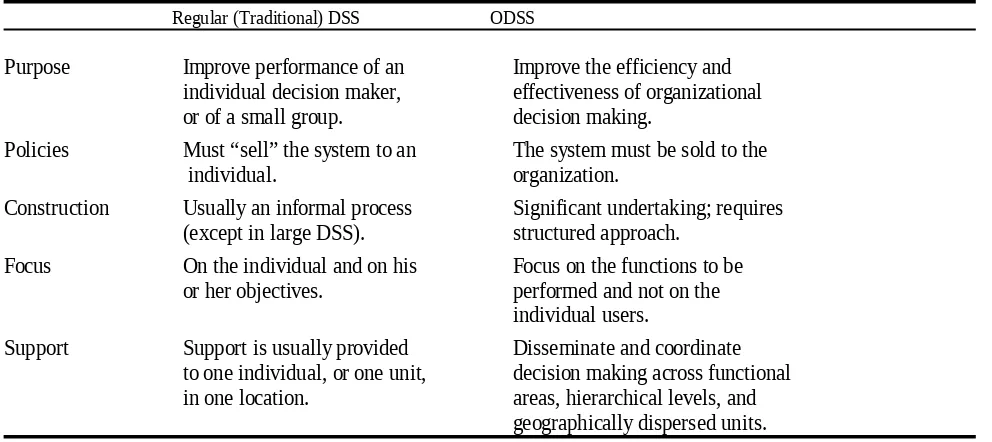Chapter 11: Executive Information
and Support Systems
DSS have been rarely used by top
executives
Why?
What are the needs of top
executives?
What is needed in computer-based
Unique MSS Tools
Executive Information Systems
(EIS)
Executive Support Systems
(ESS)
and Organizational DSS (ODSS)
Plus
Client/Server Architecture (C/S)
11.1 Opening Vignette:
The Executive Information System
at Hertz Corporation
The Problem
High competition
Keys to Success - Marketing and flexible planning
Instantaneous marketing decisions (decentralized)
Based on information about cities, climates,
holidays, business cycles, tourist activities, past
promotions, and competitors' and customers'
behavior
Must know competitors’ pricing information
The Problem
- How to provide accessibility to this
The Initial Solution:
A Mainframe-Based DSS
(1987)
Later: The Executive Information System (EIS) in 1988
PC-based front-end to the DSS
Commander EIS (Comshare Inc.)
Tools to analyze the mountains of stored information
To make real-time decisions without help
Extremely user-friendly
Maintained by the marketing staff
Continuous upgrades and improvements
Conformed to how Hertz executives work
Implementation and acceptance were no problem
System allows Hertz to better use its information and IS
11.2 Executive Information
Systems: Concepts and
Definitions
Tool that can handle the executives’
many needs for timely and accurate
information in a meaningful format (DSS
In Focus 11.1)
Most Popular EIS Uses
–
Decision making (by providing data)
–
Scheduling (to set agendas and schedule
meetings)
–
Email and electronic briefing (to browse
data and monitor situations)
TABLE 11.1 Reasons for Using EIS
Purpose for Using EIS
Percent of EIS Users
Decision Making
50.0
Scheduling
50.0
43.8
Electronic Briefing
37.5
Tickler and Follow Up Functions
31.3
Other
6.3
DSS In Focus 11.1: Why EIS?
Most common benefits: Improvement in the quality and quantity of
information available to executives. Factors identified by Watson et
al. [1991] and Watson et al. [1997]:
Information Needs (Internal and External):
More timely information
Greater access to operational data
Greater access to corporate databases
More concise, relevant information
New or additional information
More information about the external environment
More competitive information
Faster access to external databases
Faster access to information
Reduced paper costs
EIS Improvements in Executive J ob Performance Ability
:
Enhanced communications
Greater ability to identify historic trends
Improved executive effectiveness
Improved executive efficiency
Fewer meetings, and less time spent in meetings
Enhanced executive mental models
Improved executive planning, organizing, and controlling
More focused executive attention
Majority of personal DSS support the
work of professionals and middle-level
managers
Organizational DSS support planners,
analysts, and researchers
Rarely do top executives directly use a
DSS
Executive Information Systems (EIS)
(or Executive Support Systems (ESS)
EIS - Rapid growth
Prime Tool for Gaining Competitive
Advantage
Many Companies - Sizable Increase in
Profits with EIS
Sometimes the Payback Period is
Measured in Hours
New Internet / World Wide Web and
EIS and ESS Definitions
Executive Information System (EIS)
A computer-based system that serves the
information needs of top executives
Provides rapid access to timely information
and direct access to management reports
Very user-friendly, supported by graphics
Provides exceptions reporting and
"drill-down" capabilities
Executive Support
System (ESS)
A Comprehensive Support System
that Goes Beyond EIS to Include
Communications
Office automation
Analysis support
Intelligence
11.3 Executives’ Role and
Their Information Needs
Decisional Executive Role (2
Phases)
1. Identification of problems and/or
opportunities
2. The decision of what to do about them
Flow Chart and Information Flow
(Figure 11.1)
Methods for Finding
Information Needs
Wetherbe's Approach [1991] (Figure 11.2)
1. Structured Interviews (Table 11.2)
–
IBM's Business System Planning (BSP)
–
Critical Success Factors (CSF)
–
Ends/Means (E/M) Analysis
2. Prototyping
Watson and Frolick's Approach [1992]
– .
Asking (interview approach)
– .
Deriving the needs from an existing information
system
– .
Synthesis from characteristics of the systems
– .
Discovering (Prototyping)
TABLE 11.2 Methods and Sample Questions for
Structured Interviews
Method
Sample Interview Questions
1. The executive interview portion of IBM's Business System Planning (BSP): Specify problems and decisions
a. What are the major problems encountered in
accomplishing the purposes of the organizational unit you manage?
b. What are good solutions to those problems? c. How can information play a role in any of those
solutions?
d. What are the major decisions associated with your management responsibilities?
e. What improvements in information could result in better decisions?
2. Critical success factors (CSF): Specify critical success factors
a. What are the critical success factors of the
organizational unit you manage? Most managers have four to eight of these.
b. What information is needed to ensure that critical success factors are under control?
c. How do you measure the specific CSFs? For example: prompt shipment of orders (a CSF) is measured by the percentage of time shipments are delivered on schedule.
3. End/means (E/M) analysis: Specify effectiveness criteria or outputs and efficiency criteria for processes used to generate outputs
a. What are the resulting goods or services provided by the business process?
b. What makes these goods or services effective to recipients or customers?
c. What information is needed to evaluate that effectiveness?
TABLE 11.3 Methods for Assessing Information
Requirements
Interaction
Noncomputer Related
Computer Related
Direct Executive
Interaction
Participation in strategic
planning sessions
Formal CSF sessions
Informal discussions of
information needs
Tracking executive
activities
Collaborative work
system sessions (e.g.,
GDSS, Intranet)
Indirect Executive
Interaction
Discussions with support
personnel
Examination of
noncomputer-generated
information
Attendance at meetings
Software tracking of
EIS usage
Examinations of
computer-generated
information
DSS In Focus 11.3: How to Find Executives'
Information Needs
1.
Ask senior executives what questions they would ask upon
their return from a three-week vacation.
2.
Use the critical success factor (CSF) methodology.
3.
Interview all senior managers to determine what data they
think are most important.
4.
List the major objectives in the short- and long-term plans
and identify their information requirements.
5.
Ask the executives what information they would least like
for their competition to see.
6.
Either through an interview or observation process,
determine what information from current management
reports is actually being used by the executive.
7.
Provide more immediate, online access to current
management reports, and then ask executives how you can
better tailor the system to their needs. (Executives are much
better at telling you what is wrong with what you have
Volonino and Watson’s
Strategic Business
Objectives Approach [1991]
Attempts to address some potential
problems of the other methods
Ignoring soft information
Identifying the information
timeliness
Independence of information and
Organization-wide view
Identify business objectives
Link them to the information
needs of individuals throughout
the organization
EIS evolves into an
SBO Method
Determine the organization’s SBOs
Identify related business processes
Prioritize the SBOs and their related business
processes
Determine the information critical to each business
process
Identify information linkages across the SBO business
processes
Plan for development, implementation and evolution
SBO method meshes well with Business Process
Reengineering
Other Approaches
Information Success Factors
Approach
Problem: Needs Change as
Executives’ Tasks and
Responsibilities Change
11.4 Characteristics of EIS
Table 11.4
Important Terms Related to EIS
Characteristics
–
Drill Down
–
Critical Success Factors (CSF)
Monitored by five types of information
1.
Key problem narratives
2.
Highlight charts
3.
Top-level financials
4.
Key factors
TABLE 11.4 EIS Characteristics and Benefits
Quality of information:
Is flexible
Produces correct information
Produces timely information
Produces relevant information
Produces complete information
Produces validated information.
User interface:
Includes sophisticated graphic user interface (e.g., GUI)
Includes a user-friendly interface
Allows secure and confidential access to information
Has a short response time (timely information)
Is accessible from many places
Includes a reliable access procedure
Minimizes keyboard use; alternatively uses infrared controllers, mouse, touch pads,
and touch screen
Provides quick retrieval of desired information
Is tailored to management styles of individual executives
Technical capability provided:
Access to aggregate (global) information
Access to electronic mail
Extensive use of external data
Written interpretations
Highlights problem indicators
Hypertext and hypermedia
Ad hoc analysis
Multidimensional presentation and analysis
Information presented in hierarchical form
Incorporates graphics and text in the same display
Provides management by exception reports
Shows trends, ratios, and deviations
Provides access to historical and most current data
Organized around critical success factors
Provides forecasting capability
Produces information at various levels of detail ("drill down")
Filters, compresses, and tracks critical data
Benefits:
Facilitates the attainment of organizational objectives
Facilitates access to information
Allows the user to be more productive
Increases the quality of decision making
Provides a competitive advantage
Saves time for the user
Increases communication capacity
Increases communication quality
Provides better control in the organization
Allows the anticipation of problems/opportunities
Allows planning
Allows finding the cause of a problem
Meets the needs of executives.
D
SS In Focus 11.4
: Typical Ke
y Pe
rform
ance
Indicators
Profitability
Profitability m
e
asure
s for e
ach de
partm
e
nt, pro
duct,
re
g
ion, and so o
n; com
pariso
ns am
ong
de
partm
e
nts and
products and w
ith com
pe
titors
Financial
Financial ratios, balance
she
e
t analysis, cash re
se
rve
po
sition, rate
of re
turn on inve
stm
e
nt
M
arke
ting
M
arke
t share
, adve
rtise
m
e
nt analysis, pro
duct pricing
,
w
e
e
kly (daily) sale
s re
sults, custo
m
e
r sale
s pote
ntial
Hum
an
Re
source
s
Turno
ve
r rate
, le
ve
l of job satisfactio
n
Planning
Corporate
partne
rship ve
nture
s, sale
s g
row
th/ m
arke
t
share
analysis
Econom
ic
Analysis
tre
M
arke
nds, labo
t tre
nds, fore
r co
st tre
ig
nds
n trade
s and e
xchang
e
rate
s, industry
Consum
e
r
Status Access
–
Analysis by
•
Built-in functions
•
Integration with DSS products
•
Intelligent agents
Exception Reporting
Use
of
Color
Navigation of Information
11.5 Comparing EIS and MIS
Relationship between MIS and EIS (Figure 11.3)
–
MIS is TPS based
–
MIS typically lacks data integration across functional
areas
–
Differences (Table 11.5)
–
MIS does not accommodate many users’ decision styles
–
Often has slow response time
–
Executive decision making is complex and
multidimensional
–
MIS usually designed to handle fairly structured,
simpler configurations
–
MIS do not usually combine data from multiple sources
TABLE 11.5 MIS and EIS: A Comparison
System
Primary
Purpose
Primary
Users
Primary
Output
Primary
Operations
Time
Orientation
Example
MIS
Internal
monitoring
Managers
and
executives
Predefined
periodic reports
Summarize
information
Past
Sales report
EIS
Internal and
external
monitoring
Executives
Predefined
customized
periodic or ad
hoc reports,
presentations,
and queries
Integrate
present, track
CSF
Past, present
and future
Market
share
tracking
11.6 Comparing and
Integrating EIS and DSS
Tables 11.6 and 11.7 compare the
two systems
–
Table 11.6 - Typical DSS definitions
related to EIS
–
Table 11.7 - Compares EIS and DSS
TABLE 11.6 Definitions of DSS Related to EIS
Relevant Portion of DSS
Definition
Author
Comparison to EIS
"CBIS consisting of three
subsystems: a problem-solving
subsystem . . ."
Bonczek et al. [1980]
No problem-solving subsystem
exists in an EIS.
"DSS can be developed
only
through an adaptive process . . ."
Keen [1980]
EIS may or may not be
developed through an adaptive
process.
"Model-based set of procedures .
. ."
Little [1970]
EIS is not model-based.
"Extendible system . ..
supporting decision modeling. . .
used at irregular intervals."
Moore and Chang [1980]
EIS is not extendible, might
not have modeling capabilities,
and is used at regular intervals.
TABLE 11.7 Comparison of EIS and DSS
Dimension
EIS
DSS
Focus
Status access, drill down
Analysis, decision support
Typical users
Senior executives
Analysts, professionals, managers (via
intermediaries)
Impetus
Expediency
Effectiveness
Application
Environmental scanning, performance
evaluation, identification of problems and
opportunities
Diversified areas where managerial decisions
are made
Decision support
Indirect support, mainly high-level and
unstructured decisions and policies
Supports semistructured and unstructured
decision making, and ad hoc, but some repetitive
decisions
Type of information
News items, external information on customers,
competitors, and the environment; scheduled
and demand reports on internal operations
Information to support specific situations
Principle use
Tracking and control; opportunity identification Planning, organizing, staffing, and control
Adaptability to individual
users
Tailored to the decision-making style of each
individual executive, offers several options of
outputs
Permits individuals' judgments, what-if
capabilities, some choice of dialog style
User-friendliness
A must
A must if no intermediaries are used
Processing of information Filters and compresses information, tracks
critical data and information
EIS triggers questions, answers are worked out
by using the DSS and fed back into the EIS
Supporting detailed
information
Instant access to the supporting details of any
summary ("drill down")
Can be programmed into the DSS, but usually is
not
Model base
Limited built-in functions
The core of the DSS
Construction
By vendors or IS specialists
By users, either alone or with specialists from
the Information Center or the IS Department
Hardware
Mainframe, RISC Workstation, LANs, or
distributed systems
Mainframe, RISC Workstation, PCs, or
distributed systems
Nature of software
packages
Interactive, easy access to multiple databases,
online access, sophisticated DBMS capabilities,
complex linkages
Large computational capabilities, modeling
languages and simulation, application and DSS
generators
Nature of information
Displays pregenerated info about past and
present, creates new information about past,
present, and future
Integrating EIS and DSS:
An Executive Support
System (ESS)
EIS output launches DSS
applications
Intelligent ESS
Users' roles
–
Commander Decision (Figure
11.4)
Integrating EIS and Group
Support Systems
–
EIS vendors - Easy interfaces with
GDSS
–
Some EIS built in Lotus Domino /
Notes
–
Comshare Inc. and Pilot Software,
Inc. - Lotus Domino/Notes-based
enhancements and
11.7 Hardware and Software
EIS Hardware
–
Mainframe computers using graphics terminals
–
Personal computers connected to a mainframe, a
minicomputer, or a powerful RISC workstation
–
Departmental LAN or a client/server architecture
–
An enterprise-wide network, or on a client/server
enterprise-wide system. Workstations perform
high-speed graphics displays
EIS (Enterprise Information System,
EIS Software
Major Commercial EIS Software
Vendors
–
Comshare Inc. (Ann Arbor, MI;
http://www.comshare.com)
–
Pilot Software Inc. (Cambridge, MA;
http://www.pilotsw.com)
Application Development Tools
–
In-house components
–
Comshare Commander tools
–
Pilot Software’s Command Center Plus and
D
S
S
In
F
o
c
u
s
W
1
1
.*
: R
e
p
r
e
s
e
n
t
a
t
iv
e
E
IS
/ E
S
S
In
t
e
g
r
a
t
e
d
P
r
o
d
u
c
t
s
1
.
C
o
m
m
a
n
d
e
r
E
IS
.
T
h
is
s
y
s
t
e
m
h
a
s
s
e
v
e
r
a
l b
u
ilt
-in
a
n
a
ly
t
ic
a
l t
o
o
ls
, s
u
c
h
a
s
fo
r
e
c
a
s
t
in
g
. In
a
d
d
it
io
n
, it
is
d
e
s
ig
n
e
d
fo
r
e
a
s
y
in
t
e
r
fa
c
e
w
it
h
D
S
S
t
o
o
ls
.
2
.
E
IS
T
o
o
l K
it
.
T
h
is
P
C
-b
a
s
e
d
p
r
o
d
u
c
t
(
fr
o
m
F
e
r
o
x
M
ic
r
o
s
y
s
t
e
m
s
In
c
.)
w
o
r
k
s
w
it
h
E
n
c
o
r
e
P
lu
s
, a
fi
n
a
n
c
ia
l m
o
d
e
lin
g
D
S
S
fr
o
m
t
h
e
s
a
m
e
v
e
n
d
o
r
. T
h
e
E
IS
/D
S
S
c
o
m
b
in
a
t
io
n
is
d
e
s
ig
n
e
d
p
r
im
a
r
ily
t
o
s
u
p
p
o
r
t
fi
n
a
n
c
ia
l a
n
d
a
c
c
o
u
n
t
in
g
p
la
n
n
in
g
.
3
.
C
o
m
m
a
n
d
C
e
n
t
e
r
E
IS
.
T
h
is
p
r
o
d
u
c
t
(
fr
o
m
P
ilo
t
S
o
ft
w
a
r
e
, In
c
.)
, w
h
ic
h
is
lin
k
e
d
w
it
h
a
D
S
S
e
n
g
in
e
c
a
lle
d
F
C
S
a
n
d
w
it
h
D
e
c
is
io
n
S
u
p
p
o
r
t
S
u
it
e
(
s
e
e
S
e
c
t
io
n
1
1
.1
2
)
, is
a
ls
o
lin
k
e
d
w
it
h
a
s
o
ft
w
a
r
e
c
a
lle
d
A
d
v
a
n
t
a
g
e
/G
.
4
.
E
x
p
r
e
s
s
/E
IS
.
T
h
is
p
r
o
d
u
c
t
(
fr
o
m
In
fo
r
m
a
t
io
n
R
e
s
o
u
r
c
e
s
In
c
.)
is
a
n
e
n
t
e
r
p
r
is
e
-w
id
e
s
y
s
t
e
m
t
h
a
t
in
t
e
g
r
a
t
e
s
t
h
e
p
o
w
e
r
fu
l E
x
p
r
e
s
s
D
S
S
g
e
n
e
r
a
t
o
r
w
it
h
E
IS
II. T
h
is
p
r
o
d
u
c
t
is
b
a
s
e
d
o
n
a
m
u
lt
id
im
e
n
s
io
n
a
l r
e
la
t
io
n
a
l d
a
t
a
m
o
d
e
l a
n
d
it
p
r
o
v
id
e
s
s
in
g
le
, u
n
ify
in
g
, a
n
d
fl
e
x
ib
le
a
r
c
h
it
e
c
t
u
r
e
.
5
.
G
E
N
T
IA
.
T
h
is
c
lie
n
t
/s
e
r
v
e
r
a
n
d
w
e
b
-r
e
a
d
y
p
r
o
d
u
c
t
(
fr
o
m
P
la
n
n
in
g
S
c
ie
n
c
e
s
)
in
t
e
g
r
a
t
e
s
D
S
S
c
a
p
a
b
ilit
ie
s
w
it
h
E
IS
.
6
.
H
o
lo
s
.
T
h
is
p
r
o
d
u
c
t
(
fr
o
m
H
o
lis
t
ic
S
y
s
t
e
m
s
)
c
o
m
b
in
e
s
E
IS
a
n
d
D
S
S
a
c
t
iv
it
ie
s
in
t
o
o
n
e
s
y
s
t
e
m
,
t
o
g
e
t
h
e
r
w
it
h
d
y
n
a
m
ic
lin
k
s
t
o
o
p
e
r
a
t
io
n
a
l d
a
t
a
.
7
.
T
R
A
C
K
(
E
IS
)
.
T
h
is
p
r
o
d
u
c
t
(
fr
o
m
D
e
c
is
io
n
W
o
r
k
s
L
t
d
., L
o
n
d
o
n
, U
K
)
in
t
e
r
fa
c
e
s
w
it
h
IB
M
's
D
S
S
t
o
o
ls
.
Trend for EIS Software Vendors
with Third Party Vendors
Producing Specialized EIS
Applications
Comshare, Inc.’s Commander Series
–
Commander FDC
for consolidation, reporting, and
analysis of financial information
–
Commander Budget Plus
for budget development and
multidimensional planning
–
Commander Prism
for personal multidimensional
analysis and modeling
–
Arthur
- a family of supply chain focused applications
for retailing (planning, allocation and tracking)
–
Boost Application Suite
- a decision support solution
Pilot Software, Inc.
–
Budget 2000
(with EPS, Inc.) is a budgeting
application that includes the power of Pilot
Decision Support Suite for budget preparation
–
In Touch/2000
is a software agent that enables
organizations to instantly create personal
cubes (multidimensional databases), sales
reports, budget forecasts and marketing plans
–
Sales & Marketing Analysis Library
of Pilot
Decision Support Suite to perform detailed
business reporting for sales and marketing
professionals
Commercial EIS
Software
Typically Includes
–
Office Automation
–
Electronic Mail
–
Information Management
–
Remote Information Access
–
Information Analysis
Representative List of EIS
Software Products
TABLE W11.x Representative EIS Products
Product Vendor Command Center Pilot Software, Inc.
Commander DeskView, Commander
Decision Comshare, Inc. Commander EIS, EIS LAN;
Commander Decision Comshare, Inc. DSS Executive Micro Strategy Inc. Easel Workbench, ENFIN Easel Corp.
EIS Tool Kit Ferox Microsystems, Inc. Executive Decisions IBM Corp.
Express/EIS Information Resources, Inc. Focus/EIS; EDA/EIS Information Builders, Inc. Forest and Trees Trinzic Corp.
GENTIA Planning Sciences Holos Holistic Systems, Inc. IMRS On Track IMRS Inc.
11.8 EIS, Data Access, Data
Warehousing, OLAP, Multidimensional
Analysis, Presentation, and the Web
When data are delivered and viewed by
an executive, by definition, the software
is considered to be an EIS
Data warehouses as data sources for EIS
Advanced data visualization methods and
hypermedia within EIS
TABLE 11.8 EIS Hardware Options
Option
EIS Information Source
User Interface
1
Mainframe (or minicomputer
or RISC Workstation)
Graphical terminal (dumb)
2
Mainframe (or minicomputer
or RISC Workstation)
PCs
3
LAN-based PCs (or servers) on
a departmental client/server
PCs (regular, GUI)
4
Enterprise-wide network
(many possible databases)
Hypermedia over an
Intranet via a Web
Browser within the EIS
Comshare Commander
DecisionWeb
Internet Publishing module of the
Pilot Decision Support Suite
On-line Analytical Processing
(OLAP) Tools
OLAP Packages
DSS Web (MicroStrategy, Inc.)
Oracle Express Server (Oracle Corp.)
Commander DecisionWeb (Comshare, Inc.)
DataFountain (Dimensional Insight Inc.)
Pilot Internet Publisher (Pilot Software, Inc.)
WebOLAP (Information Advantage Inc.)
Focus Fusion (Information Builders, Inc.)
Business Objects Inc. (Business Objects)
InfoBeaconWeb (Platinum Technology, Inc.)
BrioQuery (Brio Technology Inc.)
Data multidimensionality - In Touch/2000 - Pilot
Pilot Software, Inc.’s
Decision Support Suite
Client/server, LAN-based, Windows-based software product
(was Lightship)
Pilot Desktop for ad hoc end-user data access
Pilot Designer for development of executive information
applications
Pilot Analysis Server for access to multidimensional data
models
Pilot Discovery Server for data mining and predictive
modeling
Pilot Internet Publisher for publishing multidimensional
data on the World Wide Web
11.9 Enterprise EIS
Tool for Enterprise Support
–
Executive-only EIS
–
Enterprise-wide Information System
–
Functional Management DSS Tools are
Integrated with EIS
–
EIS is Diffusing Lower into Organization
Levels
EIS = Enterprise Information System
TABLE 11.9 Level of Management Using EIS
Level of Management Using EIS
Percent of EIS Users
CEO
50.0
President
31.3
Vice-President
93.8
Middle Management
87.5
Other
18.8
11.10 EIS
EIS Development
Success Factors (Table
11.10)
Committed Executive Sponsor
Correct Definition of
Information Requirements
TABLE 11.10 The Major Successful EIS Development
Factors
Factors
Total Count
(Out of 214)
Executive sponsor
32
Define information requirements
29
Top management support
22
Manage data
15
Cost considerations
14
Manage system spread and evolution
12
Manage user expectations
12
Deliver first version quickly
11
Manage organizational resistance
10
Link EIS and business objectives
9
Evolutionary development approach
8
EIS development support team
6
Appropriate technology
5
Decide between vendor, custom software
5
Start limited, not small
5
11.10 EIS Implementation: Success or Failure
EIS Implementation - Different from DSS, CBIS
Critical Success Factors for Implementation of EIS
1. A committed and informed executive sponsor
2. An operating sponsor
3. A clear link to business objective(s)
4. Appropriate IS resources
5. Appropriate technology
6. Management of data problems
EIS Operational Success
Factors
(Table 11.11)
Deliver timely information
Improve efficiency
Provide accurate information
Provide relevant information
Ease of use
Provide access to the status of the
organization
Provide improved communications
TABLE 11.11 Successful Operational EIS Factors
Factors
Total Count
(Out of 427)
Timely information
42
Improve efficiency
32
Accurate information
29
Relevant information
25
Ease of use
24
Status access
24
Improve communications
20
Minimal or no training
15
Adaptable interface
14
Adapt to changing information requirements
14
Exception reporting
14
Convenient information
13
Standard definitions in the enterprise
10
Access external data
10
Drill down
9
Multiple modes of presentation
7
Access soft, human data
6
Access internal data
6
Accountability for providers
6
Color
6
Graphics
6
Fast response time
6
Easy to obtain hard copy
6
Motivations for
Developing an EIS
Internal in nature
Providing easier, faster access to
information
80 % - Evolving approach
Sequencing of the phases varies
More successful development efforts
include
–
Initiation
–
Definition of systems objectives
Determinates of EIS
Acceptance
Rapid Development Time
Staff Size
EIS Age
Not Ease of Use
Not High Usage
Factors Contributing to
EIS Failures
(Table 11.12)
Technology-related factors
Support-related factors
User-related factors
Most EIS fail because they do
not provide value for their
TABLE 11.12 Factors Contributing to EIS Failures
1.
Technology-Related
Factors
a.
b.
The EIS is no better than the original system
The technology is inadequate or inappropriate
c.
The interfaces are complicated or menus are
extensive
2.
Support-Related
Factors
a.
Users’ information requirements were ignored
b.
Changes in users’ information needs were not
kept up with
c.
Providing electronic reports identical to the
original paper reports with no enhancements
d.
Inadequate business knowledge among support
staff members
e.
Not addressing a significant business problem
f.
A lack of data availability
g.
Late delivery of operating data
3.
User-Related Factors:
1.
Limiting the focus of the EIS to one user
2.
Lack of commitment from users
3.
Executive sponsor’s lack of clarity for the
purpose of the EIS
4.
Not providing a means for executives to
communicate ideas and insights
5.
Users not able to communicate decisions
6.
Political resistance
Benefit and Cost
Assessment Practices
in EIS
Most Systems’ Realized
Expected Benefits Were
Lower
than Expectation
Greatest Problem - Information
Unexpected EIS
Benefits
Enhancements to the
enterprise-wide information architecture
Consolidation of data into
warehouses
Consolidation of analysis tools into
OLAP methods
Consistency of
terminology
across
11.11 Including Soft
Information in EIS
Soft information is fuzzy,
unofficial, intuitive,
Soft Information Used in
Most EIS
Predictions, speculations, forecasts,
and estimates (78.1%)
Explanations, justifications,
assessments, and interpretations
(65.6%)
News reports, industry trends, and
external survey data (62.5%)
Schedules and formal plans (50.0%)
Soft Information
Enhances
EIS Value
More in the Future
–
External news services
–
Competitor information
11.12 The Future of EIS and
Research Issues
Toolbox for customized systems - Commander EIS LAN,
Forest and Trees, and Pilot Decision Support Suite
Multimedia support (databases, video and audio news
feeds, GIS)
Virtual Reality and 3-D Image Displays
Merging of analytical systems with desktop publishing
Client/server architecture
Web-enabled EIS (Comshare Commander DecisionWeb,
Pilot Decision Support Suite Internet Publishing module,
SAS Institute Internet support enterprise software suite)
Automated support and intelligent assistance
Integration of EIS and Group Support Systems
Research Issues
Relationship between the executive
sponsor’s organizational position and
commitment level to EIS success
Most important factors when selecting an
operating sponsor?
Prediction of EIS benefits in advance
How EIS software affects the
development process and system success
Best staffing level and organizational
Most effective methods to identify executives'
information requirements
Major EIS data management problems and
their solutions
Impact of soft data on EIS success
Major problems associated with spread and
evolution
How to increase EIS functionality while
maintaining ease of use
Current Trends in EIS
More enterprise-wide EIS with
greater decision support
capabilities
Integration with other
software (Lotus Domino /
Notes and World Wide Web)
More intelligence - intelligent
Other EIS Issues
How to assess EIS benefits and
costs
How to cluster EIS benefits
depending on planned system uses
How EIS diffuses throughout the
organization
How to perform screen
management - creation,
Five Broad Categories
of EIS Benefits
(Table W11.1)
Help developers in design and
development
TABLE W11.1 The Five Categories of EIS Benefits
Categories of EIS Benefits Benefits within Each Category
1. Information
a. More timely information
b. Faster access to information
c. More accurate information
d. More relevant information
e. More concise information
2. Environmental Scanning
a. Better access to soft information
b. Improved access to external data
c. Better environmental scanning
d. More competitive information
3. Improving Executives’ Effectiveness
a. Improved communications
b. Improved executive performance
c. Save executive time
d. Improved presentation of data
4. Meeting Strategic Objectives
a. Increased span of control
b. Improved planning
c. Improved decision making
d. Better problem understanding
e. Better development of alternatives
5. Economy
a. Cost savings
b. Less paper
c. Support TQM program
11.13 Organizational DSS
(ODSS)
Three Types of Decision Support
–
Individual
–
Group
–
Organizational
TABLE 11.13 Differences between Regular DSS and
ODSS
TABLE 11.14 Differences between Regular DSS and ODSS.
Regular (Traditional) DSS ODSS
Purpose Improve performance of an Improve the efficiency and individual decision maker, effectiveness of organizational or of a small group. decision making.
Policies Must “sell” the system to an The system must be sold to the individual. organization.
Construction Usually an informal process Significant undertaking; requires (except in large DSS). structured approach.
Focus On the individual and on his Focus on the functions to be or her objectives. performed and not on the
individual users.
Support Support is usually provided Disseminate and coordinate to one individual, or one unit, decision making across functional in one location. areas, hierarchical levels, and
geographically dispersed units.
[image:72.720.142.638.168.389.2]
Organizational decision support
focuses on an organizational task or
activity involving a sequence of
operations and actors
Each individual's activities must mesh
closely with other people's work
Computer support is for
–
Improving communication and
coordination
Definitions of ODSS
A combination of computer and communication
technology designed to coordinate and disseminate
decision-making across functional areas and
hierarchical layers in order that decisions are
congruent with organizational goals and
management's shared interpretation of the
competitive environment (R. T. Watson [1990])
A DSS that is used by individuals or groups at
several workstations in more than one
A distributed decision support system
(DDSS). Not a manager's DSS, but supports
the organization's division of labor in
decision making (Swanson and Zmud
[1990])
Apply the technologies of computers and
communications to enhance the
organizational decision-making process.
Vision of technological support for group
processes to the higher level of
Common Characteristics
of ODSS (George
[1991])
Focus is on an organizational task or activity
or a decision that affects several
organizational units or corporate problems
Cuts across organizational functions or
hierarchical layers
Almost always involves computer-based
technologies, and may involve communication
technologies
Can Integrate ODSS with Group DSS and
Executive Information Systems
11.14 The Architecture of ODSS
General Structure for ODSS
(Figure 11.5)
Major Differences ODSS
Structure and Traditional DSS
–
Case Management Component
(CMS)
–
Accessible by several users, in
several locations, via LANs
Case Management
Run a model many times
Much output and many files
Helps the user manage the
large numbers of similar runs
Case = a specific run (scenario)
CMS Main Functions
1.
Record keeping of the
model cases
2.
Documenting the changes
from one run to the next
3.
Output comparison
11.15 Constructing an ODSS
Formal, structured approach
Large, complex, system
programming effort
Combination of the SDLC and
Phases
1.
Getting started (a structured,
organizational phase)
a)
Needs assessment
b)
Getting management support
c)
Getting organized. Set up steering
committee; identify project team
members
d)
Getting a plan of action
2.
Developing the conceptual
3.
Developing the system
a)
Designing the physical system
b) Developing the system's models and database
4.
Implementing and maintaining the
system:
a) Installation
b) Programming and updating system's modules
(programs)
c) Creating and updating the database
11.16 ODSS Example: The
Enlisted Force Management
System (EFMS)
Improve the effectiveness and efficiency Air Force staff
managing the enlisted force in decision-making and
information-processing
Objective: to provide a group of airmen that is best able
to support the missions and operational programs of the
Air Force
Iterative, continuous task
Decisions about force structure, promotion policies, and
the procurement, assignment, training, compensation,
separation, and retirement of personnel
Five major, independent organizational units (in three
geographically locations)
More than 125 person-years went into the EFMS
The Elements of EFMS
Model Base
–
Authorization projection
–
Grade allocation
–
Aggregate planning, programming,
and oversight
–
Skills management
Screening and Impact
Hardware and
Databases
EFMS's mainframe computer
DSS generator language,
EXPRESS
Access databases and models
Databases from
Output from another EFMS
model
Data supplied by other
branches of the Air Force
External data
–
The EFMS and other Air Force
11.17 Implementing ODSS
Important ODSS Implementation Issues
1.Steering committee for direction and control
2.Project team members join on an ad hoc
basis
3.The System Management Office (SMO)
4.Conceptual design
a) Design principles
b) Functions to be supported
c) Models
d) Data requirements
Model Base
Flexibility, adaptability and
easy maintainability
Interlinked system of many
Database
Coordination and integration
Specification of a common,
consistent, easily accessed,
centralized database
All information from one module is
automatically (instantaneously)
available to others
Internal and external data
Many modules have their own
User Interface
Common for all elements
Menu driven
Easy to learn
Easy to use
ODSS Data
Understanding or defining the
problem situation
Estimating the nature of the models
Validating the models
Running the models (input data)
Database construction and data
cleaning:
Integration and
Networking
Many models and databases
Integration of models, data,
and knowledge can be
complex
Artificial Intelligence in ODSS
–
Ideal - especially in CMS and
Summary
EIS serves the information needs of
top executives and others
EIS provides rapid access to timely
information at various levels of detail
Very user friendly (user-seductive)
ESS also has analysis capabilities
Executives' work: finding problems
(opportunities) and making decisions
Finding the information needs of
Methods: CSF (Critical Success Factors), BSP
(Business System Planning), SBO (Strategic
Business Objectives) and E/M (Ends/Means)
Many EIS benefits are intangible
Drill down
Management by exception approach, centered on
CSF, key performance indicators, and highlight
charts
In contrast to MIS, EIS has an overall organizational
perspective and uses external data extensively
Trend to integrate EIS and DSS tools
Constructing an EIS can be difficult. Vendors or
consultants
EIS development tools
Intranets to deliver information to executives
Web-enabled EIS
EIS success - many factors ranging from
appropriate technology to managing organizational
resistance
The executive sponsor is
crucial
for the success of
an EIS
EIS failure - no value provided
Multidimensional analysis and presentation
Access to database information by
end-users, enterprise-wide
EIS technology and use diffusing to lower
levels of management
Data warehouses and client/server front
end environments make an EIS a useful
tool for end users
EIS can provide valuable soft information
Organizational DSS (ODSS) deals with
ODSS includes a case management system (CMS)
ODSS is used by individuals and groups and operates
in a distributed environment
ODSS deals with organizational tasks
ODSS for similar, repetitive situations involves a case
management component
ODSS is frequently integrated with EIS and/or GDSS
ODSS built using both traditional SDLC and
prototyping
Data and databases are critical to the success of ODSS
ODSS usually use several quantitative and qualitative
Questions for the
Opening Vignette
1. Explain how Hertz added an EIS that is used as a
front end to the DSS
2. Why did the new DSS not satisfy the executives’
information needs?
3. Why was it so important for the new system to
provide information that conformed to the way
executives at Hertz worked? Do you think that the
system would have been acceptable otherwise?
Why or why not?
4. What capabilities did the PCs bring to the EIS?
Appendix W11-A: The
Client/Server Architecture and
Enterprise Computing
Approach to organizing PCs,
local area networks, and
possibly mainframes, into a
TABLE W11-A.1 The Benefits and Potential Problems of the Client/Server Architecture
Feature
Benefit
Potential Problems
Networked webs of small,
powerful computers If one machine goes down, your business machines stayup. The appropriate task may be run on the appropriate computer
No one machine may be capable of storing the entire database
No one machine may be capable of performing necessary computational tasks
Parts don’t always work together. There are several possible culprits when something goes wrong Designing the division of work between client and server may be complicated
Computer arrays with thousands of MIPS; clients' aggregate MIPS beyond calculation
The system provides the power to get things done without monopolizing resources. End-users are empowered to work locally
Coordination of efforts and communication contention may occur
Some workstations are as powerful as mainframes, but cost 90% less
By giving you more power for less money, the system offers you the flexibility to make other purchases or to increase your profits
You locate or build support tools yourself
The software developed for the Mac or Windows is different from that for mainframes
The computational power may be underutilized Open systems You can pick and choose hardware, software, and
services from various vendors Too many options and / or incompatible systems maybe difficult to manage and maintain Systems grow easily and are
infinitely expandable It's easy to modernize your system as your needschange. Expanded capacity may be added incrementally
Continual upgrades may cause incompatible software problems
Older machines may not run newer software Individual client operating
environments You can mix and match computer platforms to suit theneeds of individual departments and users Managing and maintaining a variety of small systemscan be difficult
C/S Characteristics
The clients are PCs or workstations,
attached to a network. Clients access
network resources
The user interfaces directly with the client
(via GUI)
Servers provide shared resources to several
clients
A server provides clients with service
capabilities (databases, large disk drives, or
communications)
Servers can be workstations, mainframes,
A client forms one or more queries or commands, in
a predefined language such as SQL, for presentation
to the server
Clients can send queries or commands to the
servers
Server transmits results to client's screen
Typical servers: database server, file server, print
server, image-processing server, computing server,
and communication server (Web server)
Server only reacts to client's requests
Servers can communicate with each other
Tasks are split into two: front-end portion (client),
Changes the way people work
People are empowered to access
databases
Client/Server
Applications Categories
Messaging applications, such as
electronic mail
Disseminating a database among
several computer networks
Offering file- or peripheral-sharing,
or remote computer access
Processing-intensive applications
Enterprise-wide Client/Server
Architecture
Computing systems that involve an entire organization
Architecture for an integrated computer system to
serve the business needs of the enterprise
Technological framework that contains multiple
applications, hardware, databases, networks, and
management tools, usually from multiple vendors
Requires a consensus on a set of standards ranging
from operating systems to telecommunication
protocols
Requires a consensus on a common open management
Major Benefits of
Enterprise Computing
Reliable and responsive service
Smooth incorporation of new
client/server solutions with existing
approaches
Frequent and rapid changes, and
increasing complexity
Greater optimization of network and
system resources
Enterprise client/server architecture
provides total integration of
departmental and corporate IS resources
Provides better control and security over
data in a distributed environment
IS organizations can maximize the value
of information by increasing its
availability. Enterprise client/server
computing empowers organizations to
–
Reengineer business processes
–
Distribute transactions to streamline
operations
